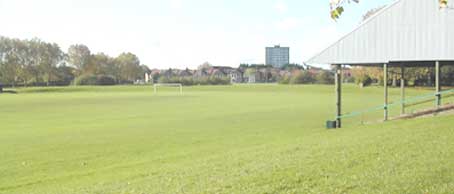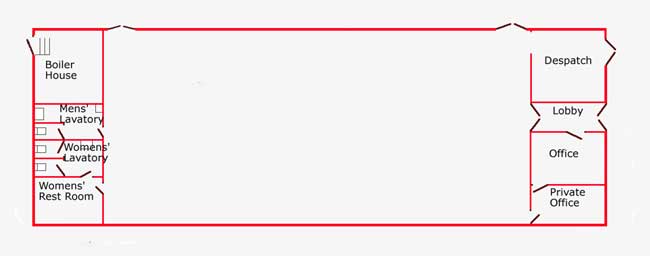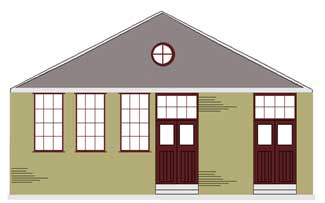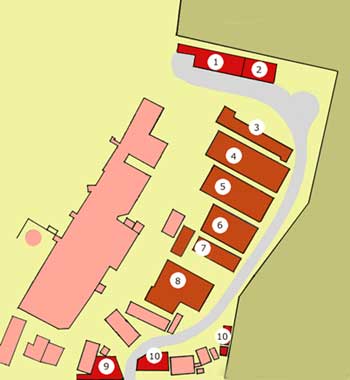|
UPDATE No 49 |
||||||||||||
|
BRICKFIELD |
||||||||||||
|
Site of South brickfield, Bury Street, Edmonton |
||||||||||||
|
By 1896 Joseph South junior (1850-1897) had purchased 13 acres of land off Bury Street, Edmonton, on which he operated a brickfield. He was also involved, on his own account, with house building and cartage. It was whilst walking across the brickfield with his foreman and brother-in-law, William Webb, in January 1897, that Joseph fell over and suffered an injury from which he died four weeks later (Update No. 12). The following year, 1898, his widow Sarah sold the brickfield to Samuel South(1) who continued the business along with his other commercial interests. Trading at the brickfield seems to have ceased shortly before the First World War and after his death in 1919 the executors of the estate of Samuel(1) sold the land to the Edmonton Urban District Council in 1925 for £4,000. The site was laid out as the Henry Barass Sports ground (Henry Barass was a prominent local councillor) and in more recent years is used as a general recreation ground. Remaining undeveloped, and with some imagination, the South brickfield can be visualised. |
||||||||||||
|
Samuel South (1) 1853-1919 |
||||||||||||
|
It was known that Samuel South(1) (1853-1919) was a Strict Baptist and worshipped at a small chapel in Claremont Street, Edmonton (Update No. 37). Further information about his involvement with that faith has become available but was too late to include, in its entirety, within the recently published history of the South family "South from Barley". The minutes of the Chapel meetings are held at the Standard Gospel Library, Hove, and a visit to the archive produced interesting information. Strict Baptists had separated from the main body of the faith because of doctrinal differences but there were further conflicts of belief within the separated movement itself. The members of the Edmonton Chapel adhered to the Articles of Faith propounded by the Standard Gospel religious magazine. Samuel(1) was not admitted as a member of the Chapel until the comparatively late age of 39. The minutes for 8 July 1891 record: Mr S South a candidate for Membership who by appointment had been seen by Mr W Howe and Mr. J Hoy and recommended by them to the Deacons was now invited to relate before the Church a little of what he hoped the Lord had done for his soul, which he did in a few short, simple, honest expressions which commended him to those present and he was by the Church unanimously received, his baptism, as per Rule, to take place at the earliest opportunity. At a later meeting on 21 October 1891 it was reported that Samuel(1) was to be baptised at a chapel in Greenwich the following evening. Baptism required total immersion and the Edmonton Chapel did not have the facilities for this not having been built originally as a Baptist chapel. Samuel(1) became a Deacon of the chapel; was appointed a Trustee in 1901; and was voted into the post of Treasurer in 1918. The reason for the late entry into the Strict Baptist faith can only be speculated. There would have been a period of attendance necessary before his admittance in 1891 but certainly not for the remainder of his earlier adult life. His father, Joseph South, and elder brother, Joseph junior, were adherents of Primitive Methodism and it likely that Samuel(1) followed their example at that time. A suggestion has been made in the family that Samuel(1) changed his religious adherence in order to further his commercial interests because other local businessmen were also members of the chapel congregation. The minutes, however, do not lend support to this inference. Such influential persons have not been immediately identified although it is correct that Samuel Pedley, a local notable and benefactor, was a fellow worshipper. Samuel was senior partner of Pedley, May & Fletcher, solicitors, who acted for Samuel South(1) and provided finance by way of mortgage for many of his property deals. Pedley does not seem to have played a leading role and the evidence is that the management of the Chapel was carried out in a democratic manner. Both William Buckle and William Welfare, who can be reasonably identified as the coachman and gardener in the household of Samuel Pedley at his large house in White Hart Lane, Tottenham, are recorded as being prominent in the administration. On the death of Samuel(1) in January 1919 fulsome tributes were paid by the members of the Chapel and the Standard Gospel magazine which recorded that in his public prayers he often used the words;
Prepare me,
gracious God to stand before Thy face; The quotation appears on his headstone in Edmonton cemetery (Update No. 44). |
||||||||||||
|
POTTERIES |
||||||||||||
|
Enquiries with the Haringey Planning Department have established that in 1938 the Wood Green Council granted permission to proceed with the erection of the first unit, designated Factory No. 5, of seven factory premises which Samuel South & Sons proposed to erect in the north-east corner of their White Hart Lane pottery land. The development would have involved the demolition of the former stables and wheelwright's shop (Update No. 39 for plan of potteries). The site was adjacent to the original claypit which had been filled in by that time. |
||||||||||||
|
Enhanced floor plan of Factory No. 5 - June 1938 |
||||||||||||
|
Unit No. 5 had an area of approximately 6,600 square feet and incorporated office accommodation, a separate despatch area together with male and female washroom facilities. The remaining six, smaller, units were to contain some 3,100 square feet. Each unit was to be constructed with a steel frame clad in cement and sand rendered brickwork and roofed with corrugated asbestos sheeting. A new access road to the factory estate was to be constructed and the planning proposals included provision for an extension of the roadway for further development of the site in the future. |
||||||||||||
|
|
||||||||||||
|
In the event, the development of the seven factories did not proceed. The reasonable assumption to be made is that the outbreak of the Second World War the following year, and the closure of the Potteries for the duration, caused the project to be deferred. After the war development of the site was begun albeit on a different basis. Individual plots were leased to tenants who erected their own buildings rather than premises being provided for them. Thoran Engineering Co. Ltd. were occupying a site by 1948 to be followed by further five tenants. Another four tenants occupied former pottery buildings no longer in use including the stable block. After the pottery land was sold in 1960 the tenants, who had erected their own premises, remained until the expiry of the leases and the buildings existed until at least 1973. |
||||||||||||
|
KLB 6/06 |



